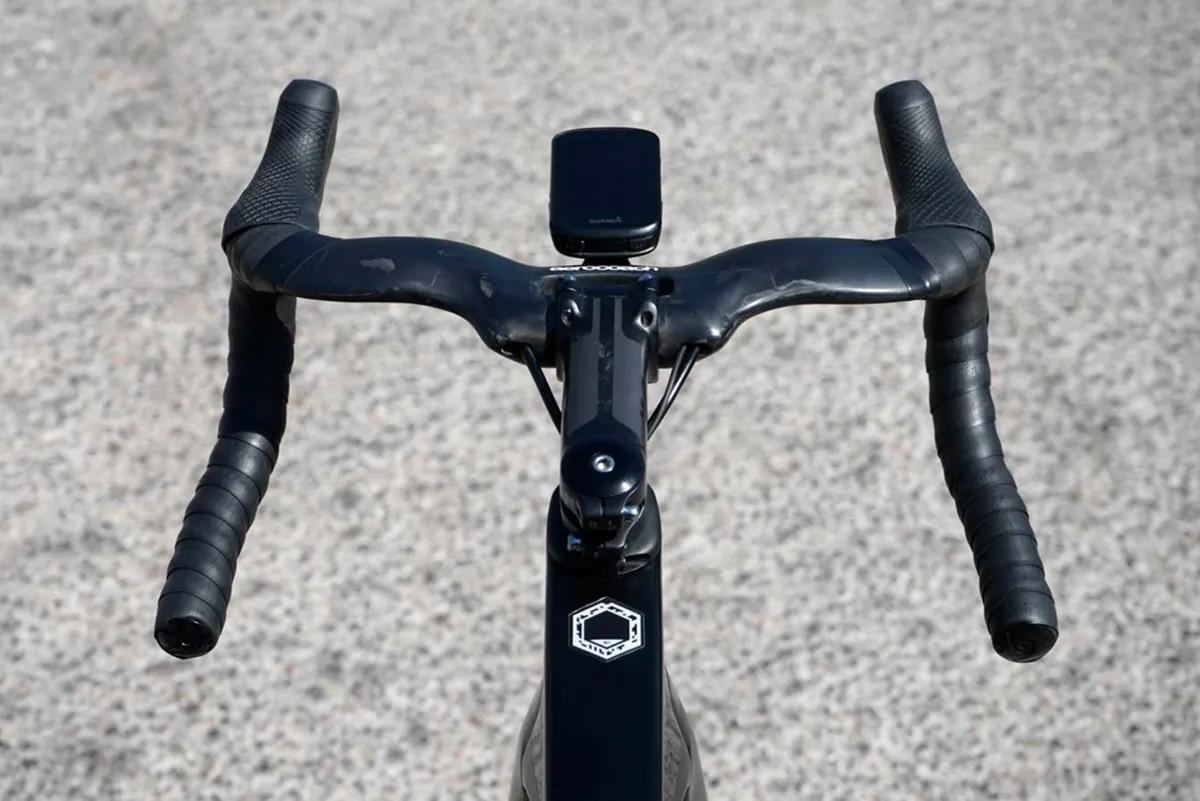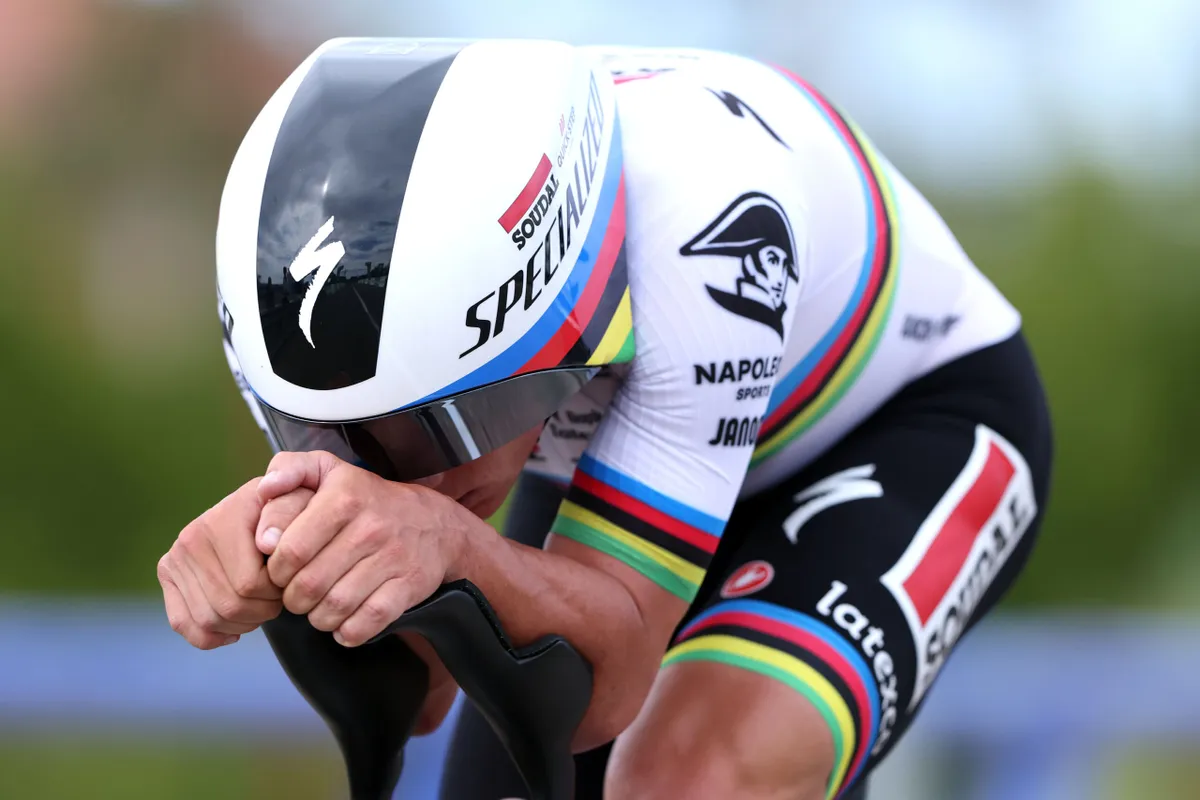The Union Cycliste Internationale (UCI) – the sport’s international governing body – has indicated it is set to restrict the use of turned-in brake levers in 2024 and beyond.
Tilting the brake lever hoods inwards has become increasingly popular in road cycling in recent years, thanks to its purported aerodynamic benefits and the influence of riders such as Remco Evenepoel, Tadej Pogačar and Taco van der Hoorn.
Citing concerns that the “extreme inward inclination” of brake levers could limit “braking capacity” and “constitutes a modification of the product beyond its intended use”, the UCI has now moved to regulate this trend.
Announced as part of a series of updates stemming from its annual stakeholders seminar, the UCI also indicated new regulations governing this would come into force from 2025.
These will require riders to comply with installation guidelines specified by component manufacturers.
Is this the end of marginal front-end aero gains, then? Or will enterprising riders and component manufacturers be able to find leeway within the new rules to exploit the potential performance gains available? Let’s find out.
What is the UCI banning?

Specifically, the UCI is looking to restrict and eventually regulate the installation angle of brake levers on road bikes.
The majority of road bike handlebars are designed for the brake levers to be installed in line with the drops.
For a standard drop handlebar, this typically results in the brake levers pointing directly forward.
With the so-called ‘puppy-paws’ position being banned in 2021, many riders looking to adopt a narrower, potentially more aerodynamic riding position opted to tilt their brake levers inwards.

In the absence of any regulations surrounding brake lever positioning, some riders have since taken this to extreme lengths.
The prologue at the 2023 Tour Down Under saw many riders adopting particularly extreme positions, for example.
Looking to address this, the UCI is set to restrict the “extreme inward inclination” of brake levers on drop handlebars in 2024, and to introduce further regulation in 2025.
These additional regulations will require riders to adhere to the installation guidelines provided by the manufacturers of brake levers and handlebars.

According to a report by Escape Collective, the UCI is also developing another bespoke tool to enable speedy bike checks by commissaires (the officials who ensure the UCI’s rules and regulations are enforced) at races.
As those familiar with the sport may know, the UCI has a penchant for introducing unique jigs and devices to check the compliance of bikes and equipment.
In 2019, for example, it introduced a gadget for checking compliance with recently introduced sock height regulations, while commissaires can also regularly be seen scanning bikes for motors.
Why has the UCI restricted inwards-tilting brake levers?
Following on from the UCI’s introduction of regulations surrounding handlebar width for 2023, cycling’s world governing body is primarily citing safety concerns as a reason for restricting the inclination of brake levers on road bikes.
According to the statement from its annual stakeholder seminar, the UCI has two primary concerns:
- The excessive inward tilt of brake levers may restrict a rider’s ability to brake safely and effectively.
- Such inclinations fall outside of the recommended installation guidelines for both brake levers and handlebars, which may pose an additional safety risk.
Speaking to Cyclingnews, Adam Hansen, the president of the Cyclistes Professionnels Associés (CPA – the largest international union of professional cyclists), said this is “not just another stupid UCI rule”.
Instead, it’s intended to ensure components don’t fail due to stresses they’ve not been designed or tested to withstand.

Hansen also claims Mick Rogers, the UCI’s head of innovation, has “research from manufacturers” suggesting brake lever angles of 10 degrees or more can cause “extra stress” on handlebars.
Rogers had even seen handlebars with “cracks” resulting from use with inwards-tilted brake levers, according to Hansen.
What does this mean for bike tech?

For a start, it almost certainly means we’ll see a much lesser degree of brake lever tilt in UCI-sanctioned events from 2024.
Notably, though, the announcement appears to still give riders and component manufacturers some leeway to use or manufacture components on which the brake levers are tilted by design.
The use of flared handlebars, which see the drops spread outwards from the tops by varying degrees, will not be banned, it seems.

Because these typically put the brake levers directly in the line with the outwards-splaying drops, the brake levers are naturally tilted inwards somewhat at the hoods.
Crucially, the ability to brake effectively is not restricted when the levers are aligned with the drops as intended.
Could we see an increased use of flared handlebars on road bikes in the future, then? We’d bet on it.
While wider flared handlebars have grown in popularity on gravel bikes in recent years, a few progressive manufacturers have introduced narrower flared handlebars for aero road bikes too.

Trek, for example, specced its latest Madone SLR with a handlebar that measures 3cm narrower at the brake hoods than at the drops.
Ribble also uses a flared handlebar on its Ultra SL R, with a hoods position that’s 4cm narrower than the drops.
AeroCoach has perhaps taken the most extreme approach to this concept, with its Ornix road handlebar.
This combines a super-narrow 325mm-wide hoods position with drops that measure 375mm wide.
AeroCoach also notes that due to the flare of the drops, “the tips of the hoods will sit around 280mm centre-centre”.
That’s narrower than what Taco van der Hoorn had on his Cube Litening C68:X TE at the 2022 Tour de France.

As riders look for ways to replicate the slipperiness of their old positions within the new regulations, we expect more component manufacturers to explore designs similar to these, particularly given the now-ubiquitous trend for integrated cockpits.
After all, when we tested this position at the Silverstone Sports Engineering Hub wind tunnel earlier this year, we found switching to a 36cm handlebar with the brake levers tilted inwards saved 2.43 watts at 35kph, compared to using a 40cm bar with straight levers.

According to Stephen Roche of The Bike Tailor, who helped us perform the test, that’s worth roughly 18 seconds over 60km.
It's not a huge amount, but certainly more than enough to make the difference between winning and losing a close race.
It’s also worth remembering that – given the power required to overcome aerodynamic drag is proportional to the cube of velocity – the absolute wattage savings would be far greater at the higher speeds WorldTour events are typically raced at.
What will the UCI come for next?

With brake lever tilt now being regulated, the obvious question remains – what marginal gains or technological innovations might the UCI come for next?
Changing the 6.8kg minimum bike weight limit (article 1.3.019) seems off the table for the time being, so we don’t expect to see bikes such as the Specialized S-Works Aethos making a comeback in WorldTour racing any time soon.
Likewise, and perhaps in a bid to get ahead of the game, the UCI has already introduced regulations surrounding the integration of bottle cages into bike frames and maximum dimensions for time trial and road bike helmets.
Might aero bars be on the chopping block?

On the subject of ‘dangerous’ handlebars that restrict riders' ability to brake safely, might the UCI ever move to ban the aero extensions seen commonly on triathlon and time trial bikes?
After all, when riders are using such extensions, they typically don’t have access to the brake levers at all, and must make a conscious effort to switch to the base bar in order to slow down.
While such a move may help to make the sport safer and more accessible (the UK’s time trial governing body, Cycling Time Trials, has recently introduced an official road bike time trial category for the latter reason, for example), we believe it’s unlikely, at least any time soon.
Given the UCI’s mishandling of the Hour Record in the late 90s through to the early 2000s (the UCI attempted to reset the regulations to ‘Merckx-era’ equipment in 1997, but eventually relented in 2014 after it turned out few professional riders, teams or their sponsors had any interest in that), we suspect it will leave aero bars alone for the time being.
Heads up!

Perhaps more likely is some sort of regulation or directive concerning ‘head down riding’, particularly during time trials.
Because heads are typically not very aerodynamic, even when wearing a fancy aero helmet, many riders have found – either via wind tunnels, track tests or simple real-world experience – there are significant aero gains to be made if they can drop their head down between their shoulders and out of the airflow.
On a time trial bike, in particular, this can help ‘hide’ the head from the airflow behind the rider's hands, and direct the oncoming air around the rider’s body more effectively.
Unfortunately, the consequence of such a technique is it can make it very hard for the rider to see where they’re going.
This was made scarily clear during the 2023 European Time Trial Championships in September, when Stefan Küng (one of the best time trial riders in the world) crashed head-first into a metal barrier on the side of the course.

Having been riding with his head down and following markings on the road, Küng simply failed to see the barriers taking the race course in a different direction.
Speaking to SRF, Küng later admitted that during a time trial “I'm basically blind, I can only see a few metres ahead”, due to the aerodynamic riding position he feels compelled to hold.
Commenting on the crash at the time, former president of the UCI, Brian Cookson OBE, said on Twitter/X, “The crazy trend for head down riding in time trials strikes again - @UCI_cycling really must look at the technical rules to stop this.”
Of course, given the difficulty in measuring or interpreting what officially constitutes ‘head down riding’, the UCI may be taking its time in formulating any new regulations in this area.
Though its creativity never fails to impress, it seems unlikely the UCI could create another tool to allow commissaires to make quick and easy judgements on this topic pre-, mid- or post-race.
This wouldn’t be a huge step for the UCI. Riders can already be penalised for deviating from their chosen line in a sprint finish, for example, or riding in a manner that endangers themselves or their competitors.
Perhaps it’s possible the UCI will simply update its rules surrounding “dangerous” or “irregular” riding, empowering commissaires with another degree of interpretation on this subject.
